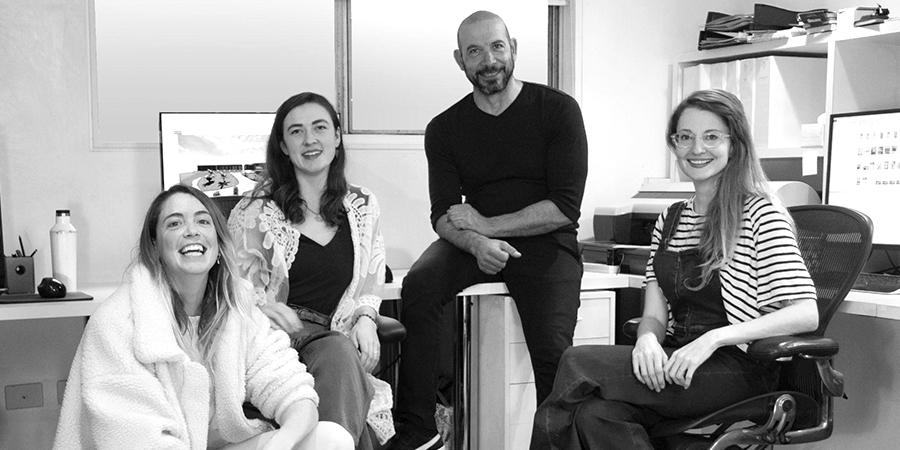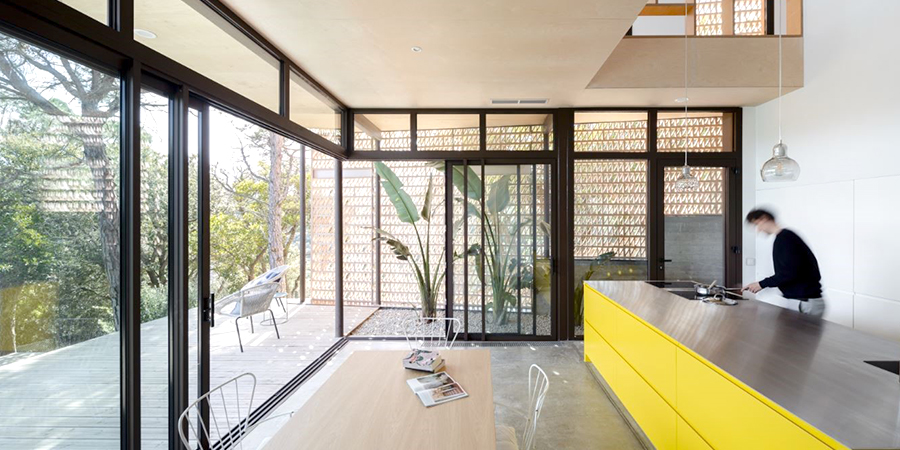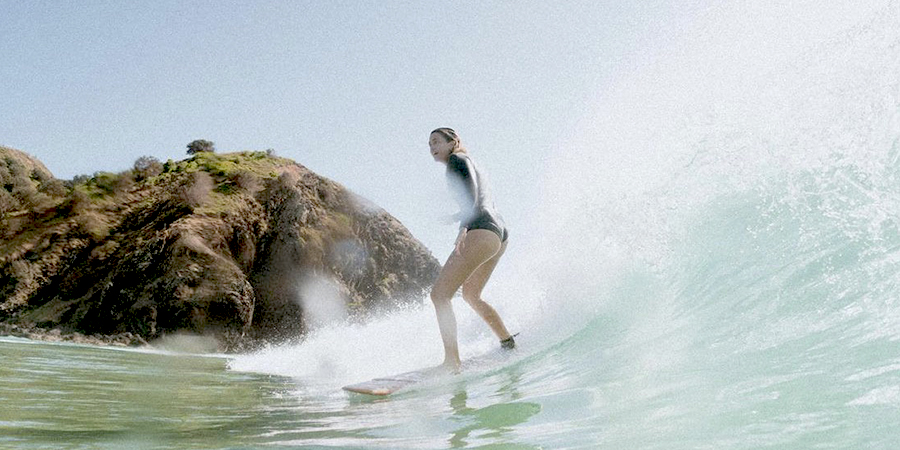- Most viewed
- Last viewed
"Travelling helped me to see that architecture can be done better”
Three days a week, Anna Perramon Domínguez gets up early to train, practise yoga or surf a little before going into work at Zaher Architects. She devotes the entirety of the remaining four days to surfing and working on her own projects. “Australian culture puts enjoying nature, free time and family above work”, she explains.
This former UIC Barcelona School of Architecture student has lived in Byron Bay for two years now, a small coastal town located in New South Wales (Australia), following four years of working at a string of unstable jobs in Barcelona. She has always been passionate about sustainable architecture and criticises the greenwashing trend that prevails in the profession, advocating instead a model that is truly committed to energy efficiency, sustainable materials and respect for the environment.
1. The slogan of the studio you work for is “Luxury that doesn't cost the Earth”. Is sustainability compatible with luxury in the field of architecture?
It is compatible, as long as the client and the architect are aware of what sustainability really means. Unfortunately, you come across a lot of projects where the scale and size they ask for are disproportionate. A lot of people have a lot of money and little common sense. For example, we are designing a 1,600 m2 house for just two people.
But, on the other hand, more and more people are looking for the luxury model we believe in: a self-sufficient house that runs independently of electricity and water networks, with more sustainable building systems and a smaller ecological footprint. Investing in new, healthier and more natural materials may be more expensive, but the improvement in climate comfort and your own future health is priceless.

2. What kind of commissions do you receive at the office and what is the workflow like for each project?
We receive many projects from clients who have a good budget margin that allows us to innovate with new construction systems for their homes, and most of them already want us to design in the most sustainable and ecological way possible. This gives us room to innovate without many limitations. For example, we have just finished a project where some of the walls have been built by mixing half concrete and half compacted earth, so at least half of the material comes from 100% natural resources. The workflow we have for each project is normally between three and six months of design and about twelve to eighteen months of construction.
3. In your experience, are there differences in how architectural projects are designed and developed between Australia and Spain? What differences have you noticed during your time working in the sector?
Yes, there are definitely differences between Australia and Spain. What strikes me most is the role of the architect. Here, you can design a house without drawing any construction details, just four floor plans and a Word document explaining where it is located and the regulations that affect it. That is all council needs to approve construction. The clients choose the engineer, the topographer and the builder and therefore if something goes wrong, the responsibility falls on each one of them. Basically, the architect is responsible for as much as they want to draw. But the more experienced and skilled you are, the more the client commissions you down to the last construction detail and, therefore, you could even end up being responsible for the construction process, which is what happens at our studio.
The other big difference is the low technical standard –both in terms of construction and in terms of sustainability– set by the Australian government. The system calculation system they use for each building system is very basic and the minimum you have to meet is also very low. This means that the houses have little insulation and, therefore lose a lot of energy. On the other hand, the low technical requirements have a great advantage in that we can innovate with many materials, which would be impossible in Spain. For example, if you wanted to build a house out of bamboo in Spain you would not have the flexibility to test the material. First it has to be officially approved and accredited to attest to the fast that it works structurally, thermally, etc. In Spain, these bureaucratic processes take a very long time which means that we lag behind when it comes to building with more sustainable materials.
4. You have always been interested in sustainable architecture. How much greenwashing is there in the sector today and what aspects differentiate a committed design from one that leans more towards appearance and opportunity?
There is a lot of greenwashing in the world of architecture, as in all industries. For me, truly committed architecture is architecture that creates projects on the basis of the lowest energy demand, both in terms of the production of building materials and in terms of the house itself. A committed design is a self-sufficient design which, by incorporating passive strategies based on the study of the sun, the materials’ thermal inertia, cross ventilation and nature itself, provides the ideal temperature in both summer and winter without the need for external energy. The little energy that is needed comes from renewable sources.

5. Which country do you think is more aware of sustainable architecture, Australia or Spain?
The truth is that I came to Australia thinking that they would be very advanced on the subject of sustainability and I have found that that’s not always the case. In Europe we are much more technically advanced, although the government in Spain, for example, makes it much more difficult to promote renewable energy. Here they pay people to install solar panels in their homes and encourage self-consumption. In Spain, we know that we are light years away from this reality.
6. You studied architecture at our School then entered the job market at a time of severe crisis in the sector. What was the start of your career like in this profession?
Quite tough. There were no jobs and studios didn't offer work placements because they didn't have enough work to give you. When I finished my degree, in the middle of an existential crisis, I started working as an apprentice at Tallfusta. I was very interested in wood and prefabrication and I already knew the people at Tallfusta because they had helped me with my Final Degree Project.
7. You then went to work with the studios Pich-Architects and Noem. What was that experience and what did you learn?
At Pich-Architects I learned from one of the most advanced studios in the field of large-scale prefabrication, a leader in the field of sustainability and innovative building systems. I had the chance to see how a large studio with very important urban planning and research projects works.
Shortly afterwards, I gave a conference on prefabricated wood construction at UIC Barcelona, and there I learned that there was a young company in Sant Cugat, Noem, that built prefabricated wooden houses. I contacted them due to my obsession with sustainability and because I wanted to learn more about prefabrication with wood. I was hired and spent three years designing projects with ten other young architects, with whom I learned a lot and grew as a team. The team was very passionate about natural materials, energy efficiency, having a small ecological footprint and optimising the construction process. It took just two weeks to erect the entire structure of a two-storey house, thus minimising costs, construction errors and, most importantly, waste and pollution. All structures were made using machined timber cut to the millimetre with CNC machines from framing panels assembled on site.
8. Why did you decide to go and live in Australia and what difficulties did you encounter upon your arrival in the country?
I thought Australia was more environmentally and architecturally conscious than Spain, and their surf and nature lifestyle appealed to me. So, I decided to take a sabbatical and fly there. When I got to Australia, I had all sorts of jobs. I was a kitchen assistant, a cleaner for incredible AirBnbs, and even a picker on a macadamia farm. Getting there was not easy, being from abroad and with the COVID-19 pandemic on top of that meant that I had to work wherever I could.
I would recommend to anyone to visit at some point in their lives to experience living and working in another culture for a while. Survival has forced me to grow a lot as a person and taught me to appreciate what is really important.
After an intense year, I realised that I missed architecture and decided to send my CV to the leading studios in Byron, where I was hired at Oceanarc Architects Byron Bay. I didn't get paid much initially and had to get a second job as a bartender in a hotel bar. But in the meantime, I was soaking up how everything worked here in Australia. What building systems they use, how the legislative and administrative systems work and especially, all the technical English terminology used in the world of architecture.
9. How is it that you came to work for Zaher Architects?
At the end of 2020 I decided to set up my own architecture firm, Arch Natur, where I developed projects alongside a former colleague. In May of that same year I was contacted by Zaher Architects, one of the studios I had sent my CV to, and they took me on. I currently work with two other girls (an Australian girl and an English girl) and Sam, the lead architect, originally from Lebanon. He is also a farmer and all-round great person. We design houses that cost between two and four million dollars, in which we try to innovate using alternative construction systems, using for example hempcrete walls, half concrete and half compacted earth walls, and timber framing with wood fibre insulation.
10. What does a typical day in the office look like for you and what hobbies do you have outside of work?
Every day I usually get up early and go to F45 training, do yoga or surf a bit and then head out to work in the studio for six or seven hours. I only work three days a week and it’s enough to live and save. The rest of the time I work on my own projects and surf.
The office is in the middle of a forest and we have ten alpacas around the property, as well as veggie plots, a beehive and several dogs. Being surrounded by nature and working six or seven hours a day makes us much more productive. Australian culture places enjoying nature, free time and family above work.

11. How do you remember your time studying at our School and which tools and techniques have helped you in developing your career?
I have many great memories, aside from how long and difficult the architecture course is. I remember the Vertical Workshop as a great opportunity to put teamwork into practice in different situations. I remember Projects and Urban Planning as subjects that teach you exactly what you will find in your day-to-day professional life. In my case, the degree helped me understand the importance of knowing how to sell myself artistically and how to convey your ideas to others. I have fond memories of my teachers who taught me a lot on a personal level, and of intense sleepless nights surrounded by great company. Only those of us who have experienced it know how intense and vocational this career is, but also how rewarding it can be.
12. What advice would you give to someone who is currently studying Architecture and wants to go on to work in the industry?
First of all, I would tell them to not use AutoCAD 2D anymore. I spent my entire degree using AutoCAD and I have never touched it again. Now you use BIM technology, which allows you to optimise your time much more. I could have saved myself so many sleepless nights! (She laughs.) Secondly, I would tell them to not feel discouraged if one year they don’t quite see the point. I went through several crises in which I doubted whether I really wanted to work in architecture. One in the middle of my degree, the next one when I finished my degree and the final one when I left Barcelona to come to Australia. In each case, travelling helped me to realise that architecture can be done better than it is being done at the moment, thanks to the examples I have seen in other countries such as Thailand, Indonesia and now here. I know it seems ironic that I dedicate my time to building if I am against destroying the planet, but I like the saying that goes “if you can’t beat them, join them”. That’s what motivates me to keep going.